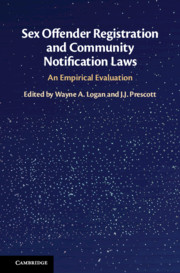Book contents
- Sex Offender Registration and Community Notification Laws: An Empirical Evaluation
- Sex Offender Registration and Community Notification Laws
- Copyright page
- Contents
- Contributors
- Preface
- Acknowledgments
- 1 Origins and Evolution
- 2 Variations in the Structure and Operation of SORN Systems
- 3 Registries and Registrants:
- 4 Law Enforcement and SORN
- 5 The Public and SORN Laws
- 6 The Ancillary Consequences of SORN
- 7 Offenders and SORN Laws
- 8 Integrating the Etiology of Sexual Offending into Evidence-Based Policy and Practices
- 9 Juvenile Registration and Notification Are Failed Policies That Must End
- Conclusion
- Index
- References
8 - Integrating the Etiology of Sexual Offending into Evidence-Based Policy and Practices
Published online by Cambridge University Press: 11 June 2021
- Sex Offender Registration and Community Notification Laws: An Empirical Evaluation
- Sex Offender Registration and Community Notification Laws
- Copyright page
- Contents
- Contributors
- Preface
- Acknowledgments
- 1 Origins and Evolution
- 2 Variations in the Structure and Operation of SORN Systems
- 3 Registries and Registrants:
- 4 Law Enforcement and SORN
- 5 The Public and SORN Laws
- 6 The Ancillary Consequences of SORN
- 7 Offenders and SORN Laws
- 8 Integrating the Etiology of Sexual Offending into Evidence-Based Policy and Practices
- 9 Juvenile Registration and Notification Are Failed Policies That Must End
- Conclusion
- Index
- References
Summary
Chapter 8 examines the disconnect between the etiology of sexual offending and the mechanics of SORN laws. Using what is known about sexual offending and the psychology of individuals who commit sex crimes, the chapter argues that registration and notification (as well as residence restrictions) are destined to be ineffective if not counterproductive. The discussion begins with an overview of the diverse etiology of sexual offending. A range of biological, psychological, and social factors can account for the commission of a sexual offense, and the specific set of causes behind an individual’s offending shape the recidivism risk they pose postconviction. The chapter refutes many common assumptions underlying SORN laws. First-time offenders who are well-known to their victims account for the majority of sex offenses. This is out of step with the “stranger danger” concept motivating SORN laws. Further, research establishes that recidivism risk diminishes over time and can be addressed through treatment. Finally, the chapter shows how SORN laws may increase recidivism risk. The stigmatization and isolation they produce, interacting with existing risk factors, may undermine protective factors and interfere with treatment gains. It argues that evidence-based, targeted laws would be more efficient and effective than current SORN laws.
Keywords
- Type
- Chapter
- Information
- Sex Offender Registration and Community Notification LawsAn Empirical Evaluation, pp. 145 - 163Publisher: Cambridge University PressPrint publication year: 2021



